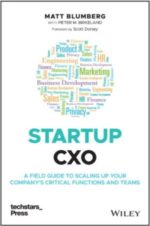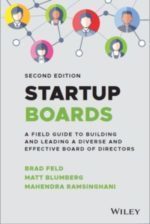I’m thrilled to announce that we created mini-books (about 80 pages long and only $9-10 on Amazon) out of five of the major functional areas covered in Startup CXO: A Field Guide to Scaling Up Your Company’s Critical Functions and Teams, part of our series along with Startup CEO: A Field Guide to Scaling Up Your Business and Startup Boards: A Field Guide to Building and Leading an Effective Board of Directors. I’ve always said that while I love all three books, in some ways Startup CXO is the best because it’s a “book of books.” While I’d still encourage all CEOs and senior executives (CXOs) to read the full manuscript, my friends and co-authors and I are happy to…
Category
Management
Why Executive Searches are So Slow, and What You Can Do About That as a Candidate
It’s been a big break between posts – as many of you probably know, I moved to Board Chair and left the CEO role at Bolster last summer (it’s now in the very capable hands of my friend and co-founder Cathy Hawley), and I’m now CEO of a super cool AI company called Acrolinx. So yes, that means I went through a job search – and I found my ultimate job as a result of an inbound cold email from a headhunter! The rich irony in that as someone who founded an executive search platform is not lost on me. So when a good friend of mine who is also between CEO gigs and looking at several opportunities asked me…
Good riddance to non-competes
I love that the FTC just banned non-competes, as everyone expected they would. Normally, I’m in favor of small government and fewer regulations, but this is one where I think the government has a legitimate interest in setting up guardrails to a free market. We started off at Return Path years ago with a standard and fairly benign non-compete because they were standard. But once California banned them and then we started doing business internationally in countries where they were illegal or not customary, we realized it was unfair to treat some employees different than others, so we got rid of them entirely and reverted to the common denominator. We don’t have them at Bolster. Restricting employees in terms of…
Decisions
Happy Leap Day! One of the better books I’ve read in the last 6 months is James Clear’s Atomic Habits: An Easy & Proven Way to Build Good Habits & Break Bad Ones, which provides a great framework around habits. It’s worth a read, whether you’re talking about business habits/routines or personal ones. This isn’t a book review, but quickly while I have you – here’s a summary of his “laws”: HOW TO CREATE A GOOD HABITThe 1st Law: Make It ObviousThe 2nd Law:Make It AttractiveThe 3rd Law: Make It EasyThe 4th Law: Make It Satisfying HOW TO BREAK A BAD HABITInversion of the 1st Law: Make It InvisibleInversion of the 2nd Law: Make It UnattractiveInversion of the 3rd Law:…
Book Short: Less is More
Subtract: The Untapped Science of Less, by Leidy Klotz is a great read, and in concert with the philosophy of the book, this will be a short blog post. The book’s basic premise is that less is more, addition by subtraction. The author’s examples range from the genius of the Strider Bike (bike without pedals) that allows 2-year olds to ride bikes to the Embarcadero in San Francisco. Many people don’t remember that that road used to be called the Embarcaro Freeway, a massive, ugly, two-tiered structure that blocked out the views and waterfront, and that the opportunity to tear down the whole thing following the massive 189 earthquake left San Francisco with a much simpler, beautiful, liveable waterfront by…
How I Engage with the CBDO
(Post 4 of 4 in the series on Scaling CBDO’s- other posts are, When to hire your first Chief Business Development Officer, What does Great look like in a Chief Business Development Officer and Signs your Chief Business Development Officer isn’t Scaling) Other than the weekly executive meeting, your day as a CEO rarely has an entry of “meet the CBDO.” Because of the infrequency of deals it’s critical to engage with the CBDO with a regular cadence so that when something does come up you’re not getting to know each other again. Anyway, a few ways I’ve typically spent the most time or gotten the most value out of CBDOs over the years are: One way to engage with…
Fighting Confirmation Bias
I was mentoring a first time founder the other day who asked me, “How do you know what advice to follow and what advice not to follow?” (For the record, it’s a little ”meta” to answer that question!). I talked about looking for patterns and common themes in the advice from others and exercising judgment about how to pick and choose from competing pieces of advice. But then he asked me how I fight confirmation bias when I’m exercising judgment and incoming advice. Fighting confirmation bias is both incredibly important and incredibly difficult, and I’d never articulated my thoughts on that before, so I thought I’d do that here. The way you have to train yourself to fight confirmation bias…
What Does Great Look Like in a Chief Business Development Officer?
(This is the second post in the series….the first one When to hire your first CBDO is here) One of the tricky things about finding a great CBDO is that the role is fairly nuanced and there’s not a degree a person can get in “business development.” So you’re left with searching for someone based partially on experience, reputation, and alignment with your company culture and goals. But over the course of my career I have figured our what “great” looks like for the CBDO and I’m confident that what worked for us at Return Path and Bolster will work for any startup. First, a great CBDO should have a good balance of the three core components Ken Takahashi outlined…
When it’s Time to Hire Your First Chief Business Development Officer
(Post 1 of 4 in the series of Scaling CPDO’s). For most startups the idea of hiring a CBDO is a pipedream, it’s a role that only global corporations have, right? After all, strategic partnerships and M&A are rare events for a startup and can be handled by the founder/CEO, or potentially by someone in Sales. If a startup is partner or channel heavy, those areas may be the focus of the Sales team in general. Or, if there is sporadic M&A activity that can be handled by external advisors or bankers. So how do you know when it’s time to hire your first CBDO? You know it’s time to hire a CBDO when you are spending too much of…
Camera On, Mic On
At my last company, we used to occasionally attend a giant meeting at one of the large ISPs — Microsoft, Yahoo, and the like — and it always annoyed me to be presenting to or engaging in a discussion with a room full of a dozen people and having all of them there with their laptops open, clearly distracted and doing other work. I’m increasingly finding annoyance with the Zoom equivalent, which is being in a meeting or attending a presentation, but turning off your mic and camera. It’s impossible to know as the person leading the meeting or speaking if you’re actually there. And if you’re there, if you’re paying attention. And how many times in a meeting can…
You’ve Seen One, You’ve Seen One
Like all CEOs and VCs, I’m a big believer in the power of pattern matching. I just wrote a whole blog post about the limits of pattern matching after hearing the quote above at a board meeting recently. But then a little alarm rang in the back of my head, and realized that I wrote about the value and limitations of pattern matching here years ago with an even better quote from my father-in-law: When you hear hoof beats, it’s probably horses. But you never know when it might be a zebra. So rather that rewrite that entire post, I thought I’d just add onto it a bit here with a current example in my head about executive recruiting and…



